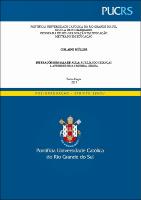| Compartilhe o registro |


|
Use este identificador para citar ou linkar para este item:
https://tede2.pucrs.br/tede2/handle/tede/7408Registro completo de metadados
| Campo DC | Valor | Idioma |
|---|---|---|
| dc.creator | Müller, Gislaine | - |
| dc.creator.Lattes | http://buscatextual.cnpq.br/buscatextual/visualizacv.do?id=K4444766H7 | por |
| dc.contributor.advisor1 | Stobäus, Claus Dieter | - |
| dc.contributor.advisor1Lattes | http://buscatextual.cnpq.br/buscatextual/visualizacv.do?id=K4793566H1 | por |
| dc.date.accessioned | 2017-06-29T14:37:23Z | - |
| dc.date.issued | 2017-02-23 | - |
| dc.identifier.uri | http://tede2.pucrs.br/tede2/handle/tede/7408 | - |
| dc.description.resumo | Este estudo foi desenvolvido a partir da teoria sociocultural de Vygostsky, direcionada, nesta pesquisa, para estudos de segunda língua e língua estrangeira, com apoio de autores como Lantolf (2006), Donato (2006), Swain (2001, 2011) e Storch (2002), os quais afirmam que a aprendizagem ocorre através da interação em um dado contexto social. O objetivo deste estudo foi observar as aprendizagens ocorridas nas interações em sala de aula de ensino de língua inglesa, quando utilizado o método Learning Fun, e analisar como as atividades desenvolvidas no ambiente educacional pela professora favoreceram aprendizagens de segunda língua. Essa pesquisa teve como participantes uma docente e sete aprendizes, com idade entre 4 e 6 anos, e ocorreu no período de novembro de 2015 a julho de 2016. Além disso, dados foram coletados através do preenchimento de um questionário com respostas abertas e fechadas pelos os pais dessas crianças. Vale ressaltar, ainda, que toda a pesquisa foi realizada em uma escola privada de Educação Infantil no município de Porto Alegre. As observações assistemáticas foram registradas pela pesquisadora em Diário de Campo e, posteriormente, esses registros foram categorizados com a Técnica de Análise de Conteúdo de Bardin em três categorias de análise a priori: (i) andaimento entre alunos/colegas e; (ii) andaimento por parte do professor e a posteriori: (i) episódios de aprendizagem. Os dados obtidos a partir do questionário foram importantes para caracterizar o grupo de alunos participantes, bem como para o desenvolvimento do projeto piloto. Os dados sugerem que o auxilio para a produção e compreensão da língua alvo ocorreu mediante o fornecimento de andaimento, tanto por parte da professora como dos alunos, reforçando a colaboração no processo de aprendizagem. Ainda, a partir dos excertos analisados, evidenciou-se que a maneira de desenvolver as aulas e o material lúdico do método Learning Fun favorecem a aquisição de língua inglesa como segunda língua. | por |
| dc.description.abstract | This study was developed from the sociocultural theory of Vygostsky, directed in this research for studies of second language and foreign language, with the support of authors such as Lantolf (2006), Donato (2006), Swain (2001, 2011) and Storch (2002) , which state that learning occurs through interaction in a given social context. The objective of this study was to observe the learning that took place in the interactions in the classroom of English language teaching, when using the Learning Fun method, and to analyze how the activities developed in the educational environment by the teacher favored learning of second language. This research had as participants a teacher and seven apprentices, aged 4 to 6 years, and occurred in the period of November 2015 to July 2016. In addition, this was complemented by filling out a questionnaire with open and closed answers by the parents of these children. It is also worth mentioning that this researsh was carried out in a private school of Early Childhood Education in the city of Porto Alegre. The unsystematic observations were recorded by the researcher in a Field Dairy. Subsequently, these records were categorized with Bardin's Content Analysis Technique in three categories of a priori analysis: (i) student / peer review; (ii) teacher and post-teacher progress: (i) learning episodes. The data obtained from the questionnaire were important to characterize the group of students participating, as well as for the development of the pilot project. The data suggest that the assistance to the production and comprehension of the target language occurred through the provision of training, both by the teacher and the students, reinforcing the collaboration in the learning process. In addition, from the excerpts analyzed, it was shown that the way to develop the lessons and playful material of the Learning Fun method favor the acquisition of English as a second language. | eng |
| dc.description.provenance | Submitted by Caroline Xavier ([email protected]) on 2017-06-29T14:37:23Z No. of bitstreams: 1 DIS_GISLAINE_MULLER_COMPLETO.pdf: 1110017 bytes, checksum: b0e5140ffa564272a42fdd741fc1521f (MD5) | eng |
| dc.description.provenance | Made available in DSpace on 2017-06-29T14:37:23Z (GMT). No. of bitstreams: 1 DIS_GISLAINE_MULLER_COMPLETO.pdf: 1110017 bytes, checksum: b0e5140ffa564272a42fdd741fc1521f (MD5) Previous issue date: 2017-02-23 | eng |
| dc.description.sponsorship | Conselho Nacional de Pesquisa e Desenvolvimento Científico e Tecnológico - CNPq | por |
| dc.format | application/pdf | * |
| dc.thumbnail.url | http://tede2.pucrs.br:80/tede2/retrieve/168898/DIS_GISLAINE_MULLER_COMPLETO.pdf.jpg | * |
| dc.language | por | por |
| dc.publisher | Pontifícia Universidade Católica do Rio Grande do Sul | por |
| dc.publisher.department | Escola de Humanidades | por |
| dc.publisher.country | Brasil | por |
| dc.publisher.initials | PUCRS | por |
| dc.publisher.program | Programa de Pós-Graduação em Educação | por |
| dc.rights | Acesso Aberto | por |
| dc.subject | Aprendizagem de Língua Inglesa | por |
| dc.subject | Colaboração | por |
| dc.subject | Andaimento | por |
| dc.subject.cnpq | CIENCIAS HUMANAS::EDUCACAO | por |
| dc.title | Interações em sala de aula : auxiliando crianças a aprender uma segunda língua | por |
| dc.type | Dissertação | por |
| Aparece nas coleções: | Programa de Pós-Graduação em Educação | |
Arquivos associados a este item:
| Arquivo | Descrição | Tamanho | Formato | |
|---|---|---|---|---|
| DIS_GISLAINE_MULLER_COMPLETO.pdf | Texto Completo | 1,08 MB | Adobe PDF |  Baixar/Abrir Pré-Visualizar |
Os itens no repositório estão protegidos por copyright, com todos os direitos reservados, salvo quando é indicado o contrário.




